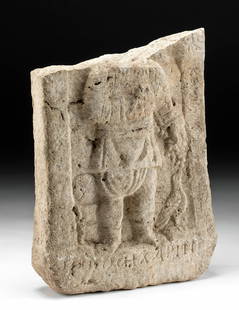
Phallic stone stela, 13th-17th century - Ethiopia,
Similar Sale History
Recommended Items






Item Details
Description
greyish brown stone (vulcanit?), rough surface structure, partly interspersed with holes, round cut, remains of clay, traces of lichen, metal base;
in today's settlement area of the Gideo and Sidama there are several impressive stelae fields that were discovered by European researchers in the 1930s. In 1935 the famous African explorer Leo Frobenius photographed a cemetery at Tuto Fela that was later excavated at the end of the 20th century by R. Joussaume. The archaeological findings showed that the grave stelae marked the graves of several deceased and that their shape indicated the importance of those buried there. As the graves are arranged in several layers on top of each other, the stelae only protrude to a fraction of their total height. The groups living in these areas often point out that the stone pillars are in remembrance of other groups who previously resided in the region but for whom they have no connection.
Many of the stone stalae, that are mainly found in the Gideo and Sidama areas, are adjudged to have been made for the Muslim war leader "Ahmet Granj", who was also known as "Dingo Makoje" by the Sidama. Apparently he rammed the stelae into the ground with one hand so that he was able to tie-up his horse. It was also reported that the Hadiyya sharpened their weapons on these stones, thus magically charging them so that they could be used for swearing in at trials. That is why the stelae were linked until recently, to weapons, combat and killing. Whatever the case, they played a role as memorial stones in a death cult and by their formal reference to the phallus they were certainly connected with a fertility cult.
H: 80 cm, H: 31,5 inch
Provenance:
Collection Sachau-Zeies, Wittlich, Germany
Lit.: Nicole Poisssonier, Das Erbe der "Helden", Grabkult der Konso und kulturverwandter Ethnien in Süd-Äthiopien, Göttingen 2009, p. 194 f.
in today's settlement area of the Gideo and Sidama there are several impressive stelae fields that were discovered by European researchers in the 1930s. In 1935 the famous African explorer Leo Frobenius photographed a cemetery at Tuto Fela that was later excavated at the end of the 20th century by R. Joussaume. The archaeological findings showed that the grave stelae marked the graves of several deceased and that their shape indicated the importance of those buried there. As the graves are arranged in several layers on top of each other, the stelae only protrude to a fraction of their total height. The groups living in these areas often point out that the stone pillars are in remembrance of other groups who previously resided in the region but for whom they have no connection.
Many of the stone stalae, that are mainly found in the Gideo and Sidama areas, are adjudged to have been made for the Muslim war leader "Ahmet Granj", who was also known as "Dingo Makoje" by the Sidama. Apparently he rammed the stelae into the ground with one hand so that he was able to tie-up his horse. It was also reported that the Hadiyya sharpened their weapons on these stones, thus magically charging them so that they could be used for swearing in at trials. That is why the stelae were linked until recently, to weapons, combat and killing. Whatever the case, they played a role as memorial stones in a death cult and by their formal reference to the phallus they were certainly connected with a fertility cult.
H: 80 cm, H: 31,5 inch
Provenance:
Collection Sachau-Zeies, Wittlich, Germany
Lit.: Nicole Poisssonier, Das Erbe der "Helden", Grabkult der Konso und kulturverwandter Ethnien in Süd-Äthiopien, Göttingen 2009, p. 194 f.
Condition
See description
Buyer's Premium
- 24%
Phallic stone stela, 13th-17th century - Ethiopia,
Estimate €7,000 - €14,000
1 bidder is watching this item.
Get approved to bid.
Shipping & Pickup Options
Item located in Wurzburg, deSee Policy for Shipping
Payment

Related Searches
TOP





















































